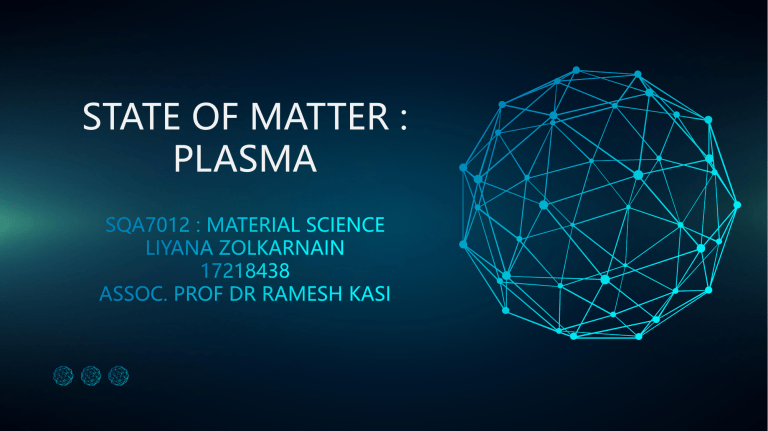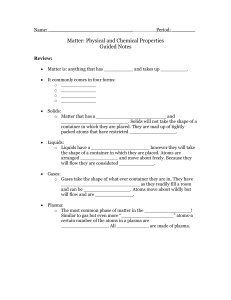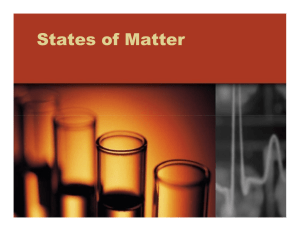
STATE OF MATTER : PLASMA Back to the beginning of the 18th century, with three English physicists—Michael Faraday in the 1830s and Joseph John Thomson and John Sealy Edward Townsend at the turn of the 19th century, understanding of the electric-discharge phenomena Irving Langmuir introduced the term plasma in 1923 while investigating electric discharges. In 1929 he and Lewi Tonks, another physicist used the term to designate those regions of a discharge in which certain periodic variations of the negatively charged electrons could occur In 1952, two other American physicists, David Bohm and David Pines, first considered the collective behaviour of electrons in metals as distinct from that in ionized gases The collective behaviour of charged particles in magnetic fields and the concept of a conducting fluid are implicit in magnetohydrodynamic studies, the foundations of which were laid in the early and middle 1800s by Faraday and André-Marie Ampère of France Two separate approaches, the study of electric discharges and the study of the behaviour of conducting fluids in magnetic fields were unified by the introduction of the kinetic theory of the plasma state. This theory states that plasma, like gas, consists of particles in random motion, whose interactions can be through long range electromagnetic forces as well as via collisions. WHAT IS PLASMA? Plasma can occur by subjecting matter to very high temperatures, to radiation or high voltages A Plasma consists of collection of free moving electron B and ion atoms that have lost electron. Energy is required strip some or all of the electrons away from atoms C Gases can become plasmas in several ways, but all include pumping the gas with energy, such as thermal, electrical or light (UV light or laser). A spark in a gas will create a plasma No defined shape and volume Plasma is distinguished from standard gases by having a good eletrical conductivity Plasma is influenced significantly by electric and magnetic fields State of matter For a plasma state to be maintained, it generally requires high temperatures. Non-thermal plasma can be created, example mercury vapor gas in fluorescent lamp There are few application in plasma, but most commonly happen and seen in daily life: Plasma lights : Fluorescent lamp, neon sign Plasma screen : Plasma TV Natural plasma : Stars In fluuorescent light, the long tube contains a gas. Electricity flows through the tube when the light is turned on. The electricity acts as an energy source and charges up the gas. This charging and exciting of the atoms creates glowing plasma inside the bulb For neon sign, the electricity charges the gas and creates plasma inside of the tube. The plasma glows a special color depending on what kind of gas is inside. Inert gases are usually used in signs to create different colors. Noble gases such as helium (He), Neon (Ne), Argon (Ar), and Xenon (Xe) are all used in signs Plasma screen made of many thousands of tiny dots called pixels which are made of three fluoresnt light elecrtrodes emitting colours red, green and blue The combination of these colours give any possible colour. The higher number of pixels , the higher the definition and images will appear sharper and more detailed Lightning is a high-current electric discharge in air, releasing most of its energy in pulses about one-hundred-millionth of a second long A typical lightning bolt carries a peak current of tens of thousands of amperes and has a peak temperature greater than 50,000˚F, about five times hotter than the surface of the sun At that high temperature the lightning column is called as plasma, a gas with many of its atoms broken into electrically-charged particles, both negatively-charged electrons and positively-charged ions. Such a gas is being ionized Lightning produce as a result of charge seperating within atmosphere and is a spark discharge between centres of positive and negative charge Big balls of gases are at really high temperatures. The high temperatures charge up the atoms and create plasma. Temperature of plasmas can be very different. Fluorescent lights are cold compared to really hot stars A Star or sun, is an almost entirely ionized ball of plasma, consisting of electrons and ions, in which there is hardly any gas (neutral atoms). The movement of the plasma produces strong magnetic fields and corresponding an electric currents THANK YOU




